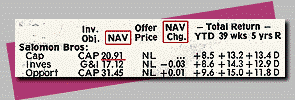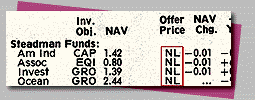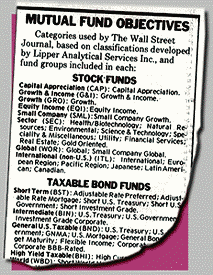
Tripod Home | New | TriTeca | Work/Money | Politics/Community | Living/Travel | Planet T | Daily Scoop
As investors have put more money into mutual funds, it's become easier to find in-depth analysis of fund performance. The funds themselves supply basic dollar and cents information about their operations to the National Association of Securities Dealers (NASD) on a daily basis. Lipper Analytical Services uses those numbers to calculate how a fund is performing and what an investment in the fund costs. Lipper also ranks the funds in relation to each other.

The Wall Street Journal tracks thousands of individual funds, quoting share price, the cost of buying, and the return on investment.
A fund must have at least one thousand shareholders, or net assets of $25 million, to be included in these performance listings, according to NASD rules. A fund is listed with other funds offered by the same mutual fund company as part of what's known as a "family" of funds. Generally, a fund family needs assets of $5 billion or so to stay alive. Otherwise, it's vulnerable to a takeover by a larger, more aggressive mutual fund company.

A mutual fund's net asset value, or NAV, is the dollar value of one share of its stock.
A fund's NAV is figured by totaling the value of all the fund's holdings and dividing by the number of shares. In this example, the NAV of the Salomon Brothers Capital Fund is $20.91.
When you sell shares of your mutual fund, the NAV is the price the fund pays to buy back each share.
NAV change is the difference between today's NAV and the NAV on the previous trading day. A (+) with the number means the fund value is up, and a (-) means it's down. Generally, the change is small - less than one percent.
An increase in the NAV over time is an indication that the value of the fund is increasing.

With many mutual funds, you pay a commission - called a load - when you buy shares.
If there's a number in the Offer Price column, it usually means you're paying a load, or commission on the purchase price. You can figure out what the load is costing you by subtracting the NAV from the Offer Price. Here, State Street Research Government Bond Fund charges a 61 cent commission on each share, the difference between the $13.50 Offer Price and the $12.89 NAV. That's about 4.7 percent.

You don't pay a commission when you buy a no-load fund.
With a no-load fund, the price you pay per share is simply the NAV, or net asset value.
Loads lower return because they reduce the amount of money that is actually being invested. A 4.5 percent sales load on a $1,000 investment, for example, means that $955 goes to buy shares and $45 pays commission.
Asset-based fees - including management and 12b-1 fees - are figured as a percentage of your total-investment and subtracted from your account every year. They are sometimes reflected in the total return figures for a fund and spelled out in the fund's prospectus, the description of its goals and business plan.
 The three-letter abbreviation following the fund name describes its investment objective.
The three-letter abbreviation following the fund name describes its investment objective.A chart explaining the abbreviations is printed every day in the Mutual Fund Quotations column of The Wall Street Journal. Each category includes from one to eight closely related but differently named objectives. Sector funds, for example, are abbreviated as "SEC" and include all the stock funds that invest in narrowly defined segments of the economy, like utilities or financial services.
Map | Search | Help | Send Us Comments